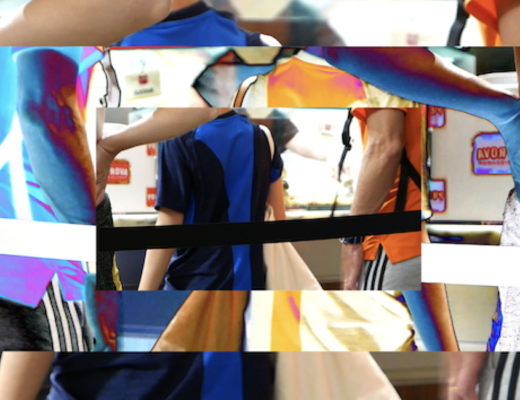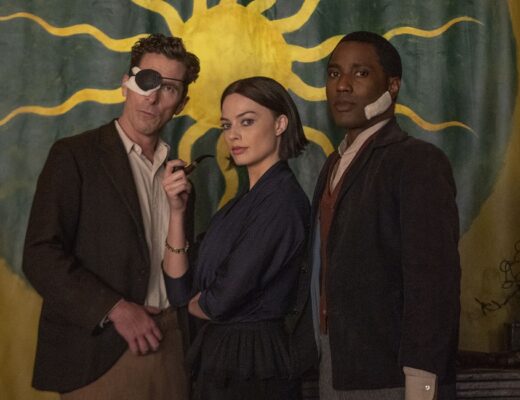Ryan: I originally intended to open this second part of our correspondence with a scene I thought was in this stretch from episodes five to seven, but it turned out to be from episode four. More than anything, I think that gives a sense of the odd way in which Irma Vep has operated in serial terms, after all one of the cruxes of the entire endeavor.
Even something as totally cohesive as Twin Peaks: The Return had reasonably discrete parts: it’s easy to isolate, say, Part 8 from Part 3, and so on and so forth. But Irma Vep has been an oddly diffuse experience, not monotone by any means — as the totally arresting and dazzling sequences in episodes six and seven definitively demonstrate — but difficult to fully reassemble in terms of an arc beyond the broadest strokes. A multitude of events occur, true, but most everything that doesn’t pertain to Mira or René could happen at any time, plugged in as they are into the firmament of a chaotic shoot. In many ways, this does mirror Les Vampires’ own unfolding, which largely eschews a fully coherent plot in favor of stunts and in-the-moment investigation.
But while Les Vampires never proceeded directly from one episode to the next, Irma Vep, existing as it does in the age of Peak TV, has a more uneasy relation with ends and beginnings. Episode five ends with a vague comment from Mira about not feeling part of Irma Vep’s world to Zoe, who doesn’t appear in the next episode, which itself begins with a startling scene with Mira on the soundstage, somewhere between possession and acting (if there’s a difference) in an ingenious use of POV. This disjunction is then rejected by the ending of episode six and the beginning of episode seven, which bisect the hotel roof intrusions into two parts; the latter created its own odd jump for me, taking place in media res but with an almost déjà-vu-esque reaction to the move back into an action that the ending of the last episode had seemed to signal was ended.
All of this is to say that there’s a certain productive dichotomy that I feel has especially come to the fore in my experience of the show. In some ways, aspects of these episodes are relatively definable: the roundelay debate about depiction of sexual assault in episode five, the procedural crisis management heavily featuring Alex Descas and Nora Hamzawi in the first half of episode six. But more and more the series has become tied to what it felt like it was proceeding toward all along, all by nature intangible and ethereal, even spooky: the layering of images from both incarnations on one another, the totally uncanny Twin Peaks-esque movement through walls, the utterly delightful recreations of Les Vampires’ filming with everyone speaking French, the expansion of René’s cut that so brazenly closed the original film, the conversations between Mira and the Chinese women she may or may not have usurped.
All above this hangs the spectre of cinema, whose terms have transitioned in the series from “merely” its status as art to something more supernatural, not least because of the introduction of footage from Kenneth Anger films. Patrick, what did you think of this development, and all that has happened in just three episodes?
Patrick: You summed up the general diffuseness perfectly, Ryan, which seems to ebb and flow with varying ideas and iterations of filmmaking, accounting not just for what certain characters posit is “cinema,” but for how they’re shut down or contested, or maybe merely questioned on the basis of unfamiliarity — I’m thinking specifically of Mira being visibly out of her depth when Regina, stepping in after René’s meltdown and disappearance to shoot a sequence, evokes Anger’s work, showing her boss examples on her phone. There’s this innate incompatibility underpinning so much of this show, which is obviously what dictates much of the drama — René is making art, others are trying to sell perfume, and so on and so forth — but Assayas is allowing it to spill over into his formatting. That kiss-off in episode five you mentioned is absolutely scintillating, an almost unceremonious fade to black, which I think also simply embodies the discombobulating experience of a Hollywood actor shooting in Paris, running the gamut from jet lag to a cultural shift which works its way down even to the architecture of a hotel room. It seems as if the entire show is mounting toward a mismatched puzzle-box of an end goal. Maybe it’s a little shrug-inducing to claim that the show is “about cinema!”, but it really is, plunging into the minutia, and refusing to swing for the declamatory.
This is conveyed on a character-by-character basis, lots of mini-conflicts bubbling to the surface, the “heaviest” ones dispelling quickly, the deceptively light ones suddenly occupying more and more space. I think of Hippolyte Giradot’s behind-the-scenes maneuvering, which sets off that aforementioned roundelay discussion of on-set ethics, all of which have reasonable weight, save for the actor himself, who is virtue signaling to the point of his own downfall. René’s Les Vampires scene in question is provocative, sure, but it didn’t do much to validate itself, considering how stilted and ineffectual his footage has been thus far, kinetic in the worst way possible, shaky-cam obscured and debilitated.
Then, when Mira points a prop-gun at René when they’re alone on set, Macgaine exhibits some believable fear; the “imaginary” tenets of filmmaking are slowly breaking down, even if René argues against such a thing in pleading his case against Robert Danjou (Giradot) — were she to pull that trigger, in all these indiscernible flights of fantasy nested in reality, could he actually be killed? And reality itself is flecked with veritable absurdity, like the chain reaction of frantic late-night telephone calls between financiers after Gottfried’s erotic-asphyxiation habit sends him to the hospital, or the Ray Liotta-like presence of a Norwegian bondage expert who was recruited “on the dark web.”
Mira, when costumed as Irma Vep, inhabits a Lynchian transience, moving across space and time via endearingly and strikingly digital special effects. But before I say more on this, how have you reacted to these increased slippages, Ryan?
Ryan: It’s probably no surprise to say that these slippages, these sudden intrusions into the relatively bland (by Assayas’ standards) style, are my favorite part of Irma Vep. Not to belabor the obvious Twin Peaks: The Return parallels that have only become more and more justified, but Nick Pinkerton once said that that production’s unnerving qualities were enhanced by its visibly chintzy special effects, akin to the cheapness of B-movie sets that suggested a real danger to the proceedings. The way Vikander walks through walls functions much the same way, all the more so because the hotel isn’t an inherently sinister place, except in its opulent emptiness.
The fluidity, in a certain way, can almost be seen as the digital replacement for the analog torrential rainstorm that so characterized the film’s version of this scene, and I was especially taken with how the film’s liberating randomness is jettisoned in favor of the series’ emphasis on tying together plot strands. The beginning of episode seven, when Mira lurks around Cynthia and Zoe’s fitting before conversing with the nonplussed Chinese actress, carries both mystery and delight, the uncanny effect and the uncannily ordinary response functioning hand in hand.
To piggyback off of this idea of absurdity, I’d like to return to the incredible sequences presented as excerpts “from Musidora’s memoir,” which are narratively irrelevant but functionally vital. In some ways, it plays directly into this idea you brought up about the minutiae of filmmaking, taking place on a set where there are no set tenets of filmmaking to speak of: there are all the crew members, but what they decide to shoot and how, even to the point of having enormous explosions and near-death by train car, is completely free. I won’t go so far as to say that Irma Vep, either film or series, is intended as an excavation of that which has been lost: Les Vampires and Irma Vep the film have never really fallen out of the conversation in the past fifty years. But, despite the delightful materiality of the sequences, they add on to the numerous phantoms both explicitly and implicitly invoked throughout these episodes.
Patrick, I’d love to hear more about this concept of space and time as it relates to Irma Vep, and how it plays into your expectations (or lack thereof) for the finale.
Patrick: You spoke of this relative visual sterility (which I think we both agree is inarguably intentional), and to me, it bolsters the show’s resolute compartmentalization of its various moving parts: flashbacks, various arcs, this increased prevalence of the hallucinatory and oneiric. Prior Assayas films have functioned like slipstreams within their respective worlds, resulting in some heady disorientation, like in Demonlover or Boarding Gate. Even if the boundaries between episodes are a little more opaque when compared to standards of television writing, Assayas nevertheless carves out space and time for the innumerable tangents the show is welcomingly piling on. One of Mira’s other exes, Eamonn (Tom Sturridge), is also shooting in Paris, and the two experience an intense recoupling, but now he’s all but dropped out — if this really is a project about the ghosts that populate film sets, than he’s yet another one, boxed away once he’s served his purpose.
Will all of this come to a head in the finale? Part of me is hoping it doesn’t, as the show has so successfully decentered ostensible priorities episode after episode — as time and space mingle more and more, any sort of resolution would have to be forward-facing, rather than drawing back on what’s already occurred. The end of episode seven teases René’s return to Les Vampires, which sets up all these conventional what ifs — how will he interact with Herman? Is he really back to shoot? Will Mira “stand up” for him, like she promised? — while also introducing the most unpredictable and combustible element back into the fold. In the interim of his absence, we’ve been treated to two excerpts of Musidora’s diaries, which, like you said, detailed Feuillade’s unwavering, dangerous commitment to his vision; if you’re injured, at least you’re paid double!
Considering that each actor has their own counterpart in the Musidora flashbacks, I expect something of a contemporary transposition for the finale — René has invoked Feuillade, but he hasn’t exactly channeled him, the moneyed strictures of modern filmmaking have consistently prevented that. In fact, it’s Regina’s on-the-fly experimentation for her brief moment in the spotlight that deserves the comparison. Perhaps the show is pushing toward an affirmation of subliminal influence, the ghost of cinema electrifying all who are open to it, whether or not they’re actually attempting an exhibition of influence (Feuillade, Anger, etc.).







